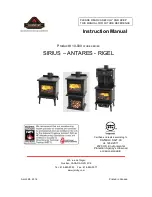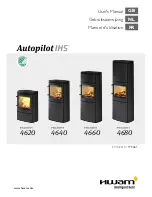
English
45
MAINTENANCE
Once a year clean the smoke chamber as follows:
• Remove the screw which secures the smoke chamber closing
element, then lift the element slightly and remove it by pulling it
towards you. (fig 66, 67).
• Use a vacuum cleaner to remove any ash and carbon deposits
which can accumulate in the chamber, taking care not to damage
the blades of the fan.
• Check the hole inside the smoke chamber at the rear (leading to
the device for measuring the vacuum) for dust and ash and clean
if necessary (fig. 68).
• After thorough cleaning, change the gasket and replace the
smoke chamber closing element.
In order to get the most from your product we recommend that this
maintenance be carried out on a monthly basis.
Remove the plug from the Tee and clean the pipes.
If necessary, particularly on the first few occasions, we recommend
calling in a qualified technician.
PULIZIA DELL'IMPIANTO DI SCARICO 1151
DT2031151
DT2031151-00
Fig. 69
DT2030247-01
Fig. 66
DT2030248-01
Fig. 67
IMMAGINE 0249
DT2030249
Pulizia foro
DT2030249-02
Fig. 68
Cleaning
the hole
The ceramic cladding must first be cleaned with a soft dry cloth before using any detergent (even mild detergent).
Products are available on the market which are suitable for cleaning ceramics as well as concentrated products for cleaning porcelain.
These will remove oil, ink, coffee and wine stains, etc.
NEVER SOAK THE CERAMIC CLADDING OR CLEAN IT WITH COLD WATER WHEN IT IS STILL HOT AS THE THERMAL SHOCK COULD CAUSE IT
TO CRACK.
When cleaning the enamelled metal parts of the product use a soft cloth moistened with water.
NEVER CLEAN METALLIC PARTS USING ALCOHOL, SOLVENTS, PETROLEUM-BASED PRODUCTS, ACETONES OR OTHER DEGREASING OR
ABRASIVE SUBSTANCES.
In the event of such substances being used the manufacturer will not be responsible for any damage caused.
Discolouration of metallic parts may be the result of misuse.
The glass should be cleaned when cold using ammonia-based degreasing agents and not corrosive substances such as solvents.
If the appliance is very slow to heat up in the ignition phase due to fuel that isn’t completely dry, this is likely to cause a build-up of tar on the
glass.
This will eventually burn off when the secondary air supply is opened (if the appliance is equipped accordingly) or when the appliance is operating
at full capacity.
If the tar is left to build up over a long period it will require more effort to remove.
We therefore recommend that the glass be cleaned daily before lighting the stove.
Do not use any material that could scratch or spoil the glass, as scratches may develop into cracks or breaks.
7.4 CLEANING THE SMOKE CHAMBER - Fig. 66 / 68
DT2010159-04
7.5 CLEANING THE FLUE SYSTEM - Fig. 69
DT2010092-03
7.6 CLEANING THE CERAMIC CLADDING
DT2010059-03
7.7 CLEANING THE ENAMELLED METAL PARTS
DT2010061-03
7.8 CLEANING THE GLASS (DAILY)
DT2010062-04












































